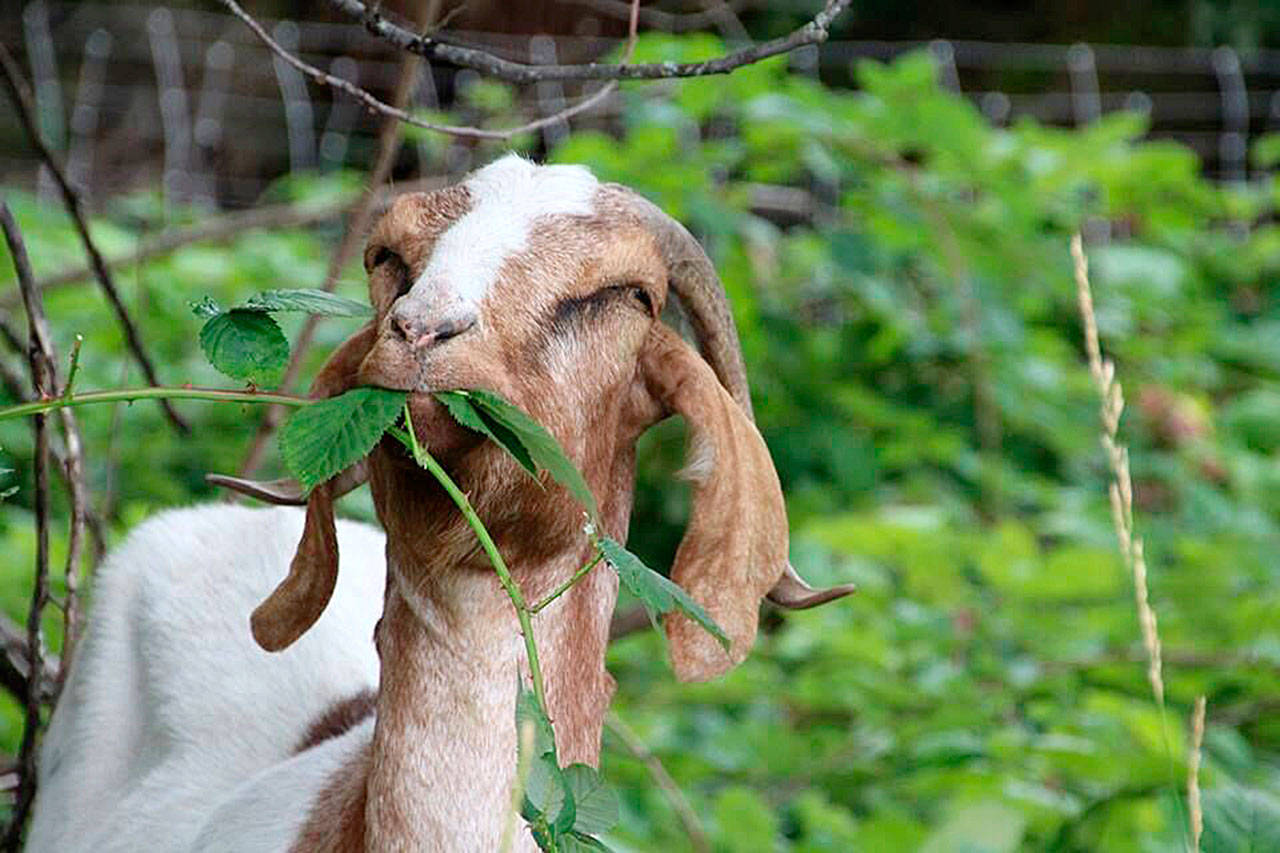By Chris Woods
The voluptuous and fecund Himalayan blackberry was introduced to America by the eccentric plant breeder Luther Burbank in 1885. Burbank had some good ideas — like elephant garlic and the freestone peach — and a few that may have seemed like good ideas at the time, but which turned out to be big mistakes, such as eugenics and the Himalayan blackberry.
Burbank originally received the seeds from a collector in India, hence the name. However, the Himalayan blackberry is native to Armenia, as is my grandmother who was also tough and prickly but incredibly sweet, if you could get past the thorns.
The Himalayan blackberry is the unsightly and ubiquitous default hedgerow on Vashon. It erodes soils, invades creeks and crowds out animal habitat. Invasive blackberry overwhelms native plants, including salmonberry, thimbleberry and trailing blackberry, which fruit earlier in the season and feed birds at a critical time.
These blackberries are invasive in part because they’re delicious. They’re also high in vitamin C, beta carotene, minerals and phytochemicals. Most plants that end up as invasive species were initially propagated by humans because they were valuable to us in some way. Writer Michael Pollan argues that plants evolved to gratify human desires so that we’d help them multiply. The blackberry offered us sweetness and sustenance, and we invited it into our gardens. It betrayed us and repays our cultivation with a blood-thirsty attack on our open spaces.
Himalayan blackberry is hard to kill, which has caused many individuals and communities to just give up trying to control it. Seattle plant expert Arthur Lee Jacobson urges perseverance and courage: “Pray for ruthless single-minded focus. Arm yourself with tough leather gloves and weapons of choice. Go to it, hacking and uprooting like a demon.” Hand-to-vine combat is important for eradicating blackberry vines, but maybe declaring war on them isn’t the only answer. In the Caribbean, locals are battling the invasive lion fish by eating as many as they can. They conduct lionfish derbies, publish cookbooks and share tips for handling its venomous spines.
Turns out lionfish are delicious — just like blackberry. In that spirit, why not have blackberry picking and eating contests, compile our pie and cobbler recipes and share tips for the best berry-picking combat gear? How about monetizing this monster vine by making blackberry brandy and wine? Vashon grows way more blackberries than strawberries these days, so perhaps we could change the Vashon Strawberry Festival to Himalayan Blackberry Days to reflect our current reality. Since goats love eating blackberry plants, we could host Goat Trials, like the Sheepdog Trials, where skilled goatherds guide their trained competitors through blackberry-ridden obstacle courses.
In 1729, Jonathan Swift anonymously published “A Modest Proposal,” a satirical essay suggesting starving Irish peasants could sell their children to the British upper classes for food.
Swift wrote, ”A young healthy child well nursed, is, at a year old, a most delicious nourishing and wholesome food, whether stewed, roasted, baked, or boiled; and I make no doubt that it will equally serve in a fricassee, or a ragout.” This outrageous essay shocked the public, but it brought attention to a problem no one wanted to deal with. Eliminating Himalayan blackberry may seem as unrealistic as eliminating poverty, but that doesn’t mean we shouldn’t keep looking for creative solutions.
Nature Calendar Aug-Sept.
Fridays, Aug. 10 & 24
Anemone Site Maintenance
Vashon Nature Center is helping coordinate volunteers to assist the Washington State Department of Natural Resources in a long-term research program related to ocean acidification. Next site visits are Aug 10 for tile exchange, cleaning sensors and counting eelgrass, and Aug 24 for tile exchange and cleaning sensors. Email mariametler.vnc@gmail.com for more information.
Saturday, Aug. 11
Vashon Audubon Field Trip
Birding on the island. Drop in, no charge, and no experience necessary. Bring binoculars and scopes if you have them and wear walking shoes or boots. Kids must be accompanied by a parent or other adult. Carpools encouraged and can be arranged at Ober Park. 8 to 10 a.m. Meet at Ober Park Park & Ride lot. See vashonaudubon.org.
Sunday and Monday, Aug. 12 and 13
Shoreline Armoring Removal Monitoring
Help BeachNET scientists and volunteers document what happens to shorelines when bulkheads are removed. Contact Maria Metler for information, meeting locations and to sign up: mariametler.vnc@gmail.com. 9:30 a.m. on Maury Island.
Saturday, Aug. 18
Matsuda Farm Open House
Come see what’s growing at the Land Trust’s Matsuda Farm. Bring a picnic and enjoy the wide open spaces and the views. Tours on the hour at 1, 2 and 3 p.m. Park at the old K2 lot and walk in. Noon to 4 p.m.
Thursday, Aug. 23
Land Trust Book Group
“Messages from Frank’s Landing: A Story of Salmon, Treaties and the Indian Way” explores the broad historical, legal and social context of Indian fishing rights in the Pacific Northwest, providing a dramatic account of the people and issues involved. 6:30 p.m. at Kneeshaw House, 11132 SW 204th St.
Thursday, Sept. 6
VNC Nature Lounge
Vashon Nature Center’s Nature Lounge returns this fall. Check back for information on topics and speakers.
Thursday, Sept. 13
Audubon Program – Native Plants for Birds
Pam Borso from North Cascades Audubon will talk about choosing native plants to make your yard a sanctuary for nesting and overwintering birds, as well as a recharge station for migrating birds. 7 p.m. at the Land Trust Building.



